Recent News Items on OTA Broadcast TV

But now a major newspaper is placing them in the same category as NAB members and multibillion dollar HBO and Netflix. Wow!
Then I noticed the tweet below from @bcbeat = Broadcasting & Cable magazine. Those of us who have been along for a while remember when Broadcasting magazine, the predecessor of today's Broadcasting & Cable, under the late Sol Taishoff, was the TV broadcasting industry's biggest cheerleader. It didn't cover broadcasting news, if was more like today's Fox News' relationship with conservative Republicans and Sol played the Rupert Murdoch role. Today B&C includes "cable" in its name, dropped all coverage of radio broadcasting, and is owned by NewBay Media, a publishing firm also in several other areas of media business publications.
After HBO, which network won the second-most awards at the 2015 Primetime Emmys? Take our annual News Quiz: https://t.co/6CbDnrQkQ2
— Broadcasting & Cable (@bcbeat) December 29, 2015Note that the B&C tweet very visibly reminds readers of the embarrassing detail, reported previously here, that mainstream OTA broadcasters are getting smaller and smaller shares of the annual Emmys. Who knows, maybe Crackle will become eligible soon?
Then I was listening to NPR last week and heard a story from their TV reviewer:
When it came to new programming, broadcast TV didn't impress critic David Bianculli much this year. But if you add in cable and streaming services, then the story changes.
All told, cable and streaming made it "another great year for TV," Bianculli tells Fresh Air's Terry Gross. The year was so good, in fact, Bianculli says he could have made a Top 20 or even a Top 30 list, but in keeping with tradition, he has narrowed it down to 10 — OK, fine, 11 — picks:
Bianculli's picks are here. They include "The only show from broadcast TV on my Top 10" - The Good Wife as #4. AMC and FX had 3 shows each, Comedy Central 2 , and Amazon and Showtime had 1 each.
So with the incentive auction coming up, we hope industry will consider why there is a flurry of such news stories. Is it a CTIA conspiracy or is it just the "writing on the wall"?
UPDATE
Concerned that we are unfairly dissing the content of OTA TV?
I was watching NBC's Today Show New Year's morning on my DVR. (See, I do watch some OTA! But usually on my DVR since most of the commercials are so annoying.) At 7:42 AM they had a segment on "What to Watch For in TV, Music, & Movies" in 2016. The person interviewed was Ms. Meeta Agrawal, Deputy Editor of Entertainment Weekly. Her recommendation for TV: USA Network's Mr. Robot.
Now I realize that USA Network is part of the same NBCUniversal that brings you the Today Show and owns the NBC affiliate in DC, but with a straight face could they have mentioned some OTA show as something great to watch for 2016? Despite all the great cheering from NAB and the kowtowing from FCC commissioners, isn't OTA TV losing to other video alternatives because of the quality of the programming they offer - independent of any spectrum policy issues?
The Importance of Remembering to Use an Anonymous Burner Phone

In the US you need valid ID to buy Sudafed and related decongestants because they can be used to make crystal meth. You need an ID to buy large amounts of nail polish remover because it can be used to make explosives. But no ID is needed for cell phones. The lack of routine data on cellphones that would be available in other countries has resulted in DEA buying from AT&T access to the Hemisphere database that “covers every call that passes through an AT&T switch — not just those made by AT&T customers — and includes calls dating back 26 years”. So this policy does not protect privacy, it leads to more invasive law enforcement invasions of privacy.
For many years Tracfone was the largest provider of burner phones, perhaps it still is. Like all providers Tracfone requires some registration before a newly purchased burner can be used. But making up false names for dozens of burners can be such a pain so Tracfone allowed a shortcut for that market segment. See the last line in the signup form that used to be on Tracfone's website? "If you wish to skip this step, please click here"

(Formerly on Tracfone website)
But now Tracfone and others require you to at least make up a false name and address. Oh, for the good old days!
But "Affluenza" teen Ethan Couch, shown above, was apparently not as smart as your average drug dealer. He should have studied Breaking Bad more carefully! CNN reports that he was tracked down based on use of his cell phone. Ethan, making up false names and entering them on carriers' websites takes time, but it is worth it. Be thankful this is the USA. No one in the US requires ID to purchase even dozens of cell phones as opposed to Sudaphed and nail polish remover. Indeed, while Title VII of the USA PATRIOT Improvement and Reauthorization Act of 2005, P.L. 109-177 limits the amount of Sudafed you can purchase, there is no limit to how many cell phones you can buy at a time in the USA. Ethan, you should have stocked up on your way to Mexico!
But, Ethan, when you get back into a US prison you can be certain that genuine burner phones will be there for your use. They are the contraband phone technology of choice for incarcerated criminals! And since FCC is moving at a glacial pace in Docket 13-111, not to mention the petition filed by a large group of state corrections officials more than 6 years ago in July 2009, the burner phones you find there will probably work well. Even in isolated rural maximum security prisons the cell phone industry has convinced FCC than only a "silver bullet"-like quixotic technology yet to be finalized poses a low enough risk to their service that FCC could allow it to disrupt prisoners from running criminal enterprises or ordering murders of witnesses. (At least CTIA has removed from its website a video from a former high ranking official there that claimed, based on an incident in Brazil, that any prison cell phone jamming could disrupt cell phone services miles away!)
We sincerely hope that there is never a cellphone-activated IED attack on US soil. But we are certain that if this were to ever happen that the types of political forces that prompted the original PATRIOT Act would promptly require draconian limits on "burner"/prepaid phones. We hope that the FCC and the cellular industry have a rational contingency plan for doing this so that legitimate uses of prepaid phones by millions of users is not disrupted by the antisocial uses that the industry now condones. And if you have such a plan, why not phase it in now?
UPDATE
Lest you think I was too hard on Tracfone above, here is the first paragraph of Sean Penn's "El Chapo Speaks:A secret visit with the most wanted man in the world" from Rolling Stone:
It's September 28th, 2015. My head is swimming, labeling TracPhones (burners), one per contact, one per day, destroy, burn, buy, balancing levels of encryption, mirroring through Blackphones, anonymous e-mail addresses, unsent messages accessed in draft form. It's a clandestine horror show for the single most technologically illiterate man left standing.
(The spelling of "TracPhones" in the article says something about Rolling Stone's attention to detail which might also explain their mess with their UVA article on the fraternity party. But it is clear which carrier they are talking about.)
Something CTIA and Wi-Fi Community Might Agree On

These days CTIA and the Wi-Fi community don't seem to agree on much due to the ongoing LTE-U/Wi-Fi controversy. But here is something that they are both likely to agree on for this weekend: Let's hope that FCC's total abdication of interest or responsibility for any aspect of drone spectrum issues does not result in spectrum chaos this weekend in the cellular bands and/or Wi-Fi bands, but possibly other bands if the drones marketed in the US are as noncompliant with spectrum emission rules as the drones marketed in Europe.
Readers may recall that we reported 10 days ago on the EU study shown at right that found high EMC noncompliance rates in the European market. Do you think Asian manufacturers are more careful with models destined for USA because they fear FCC enforcement?
This EU report observed what has been previously discussed here about the interference potential of drones that are not properly regulated:
So let's hope that the huge number of new drones that will be airborne this weekend do not result in spectrum chaos due to their location at altitudes that were not expected by cellular planners and Wi-Fi users or from out-of-band emissions. And let's hope that if they do cause interference that FCC will respond more quickly and decisively than it did in the case of "cellular boosters", police radar detector interference to VSATs, or the ongoing FM harmonic interference to 700 MHz LTE base stations - which FCC has never made a public pronouncement on.Signals transmitted from the air to the ground have a significantly bigger coverage area than from the ground. Therefore, interferences generated from RPAS could have a major impact on radio communication. This means that there is a higher risk of harmful interference if RPAS systems do not meet the essential requirements.
Perhaps serendipity might save the spectrum community this time from chaos. But really, is this the way to protect multibillion dollar industries that are deeply tied to our society and economy? Should we have an FCC that can pay attention to issues other than corporate merger review and finding more spectrum for cellular carriers?
After the holidays, readers might want to review my TPRC paper this year that deals with FCC productivity shortfalls in spectrum policy and argues that they result from BOTH resource shortages and an inability for the FCC's "8th Floor" to understand they have to delegate some issues more in order to keep up to the magnitude of their job in today's IT focused world. (General Motors board of directors does not review every design detail of next year's Chevy because they could not keep up with their strategic responsibility if they did. FCC's commissioners need to develop a more collegial relationship and decide which issues are "bottom line" for they and need limited availability en banc deliberations and which can be left to staff under agreed guidelines like Ofcom has with its staff.)
And let's all pray we avoid spectrum chaos this weekend. Best wishes to all for a happy holiday season!
Hiring Irregularities at FCC During EB "Field Modernization"?
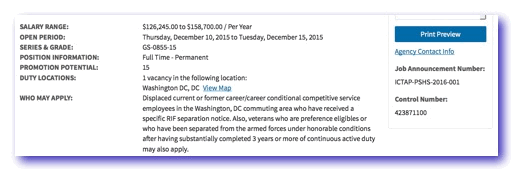
Readers know well that your blogger is not a big supporter of FCC 's "field modernization"/downsizing of spectrum enforcement staff. But this matter is now clearly res judicata as both the FCC commissioners, in a public meeting, and the relevant congressional committees have approved it.
But the very least that FCC could do for its long term field employees who are having their jobs eliminated is to treat them fairly with respect to vacancies in FCC that they could plausibly qualify for. Indeed, one might argue that FCC should go out of its way to accommodate displaced EB staffers in the hiring process by trying to save as many as possible and use their years of practical experience with telecom policy "outside the beltway" - but that would probably be expecting too much.
The job posting at the top of this item seems to indicate some hiring irregularities at FCC. While this is not unprecedented at FCC, it is especially grievous when dozens of long term loyal employees are about to be terminated.
A quick look at FCC's job posting page shows that vacancies normally have a 2 week open period. Now look at the GS-15 ($126,245.00 to $158,700.00 / Year) electrical engineer job given above. It is reasonable to assume that some of the displaced EB staffers have the proper qualifications for this position. Note that the open period is "Thursday, December 10, 2015 to Tuesday, December 15, 2015". I hear from a reliable source, but can not confirm, that this announcement was not visible on the hiring web page until Friday, December 11. Thus the actual one period was 3-4 work days, not the usual 2 weeks.
The notice the "who may apply section":
Displaced current or former career/career conditional competitive service employees in the Washington, DC commuting area who have received a specific RIF separation notice. Also, veterans who are preference eligibles or who have been separated from the armed forces under honorable conditions after having substantially completed 3 years or more of continuous active duty may also apply.
I originally took this to mean that EB field staffers displaced by "field modernization" were eligible and would be given some preference. However, multiple sources have now confirmed that no EB staffers "in the Washington, DC commuting area …have received a specific RIF separation notice" as of the open period here.
Mirage
It appears that the new posting is thus a cruel mirage for EB field staffers who are about to lose their jobs resulting rom "field modernization": it appears they might be given some preference, but in reality they are not eligible! While playing this trick on long term staffers it also appears that someone is trying to rig the job for a specific person who no doubt is a "veteran … who (has) been separated from the armed forces under honorable conditions after having substantially completed 3 years or more of continuous active duty" but may not necessarily be a current FCC employee.
As of today, there are 5 vacant announced positions at FCC.
Here is the ""Who may apply status" of each of today's FCC vacancies:
- Economics Research Assistant GS-7 "Current and former federal employees in the competitive service with reinstatement eligibility"
- Attorney Advisor GS-15 "FCC Employees"
- Program Analyst (Wireless Telecommunications) GS-12 "FCC Employees"
- Attorney Advisor (Field Counsel) GS-15 "All sources"
- Telecommunications Policy Analyst GS-15 "Displaced current or former career/career conditional competitive service employees in the Washington, DC commuting area who have received a specific RIF separation notice. Also, veterans who are preference eligible or who have been separated from the armed forces under honorable conditions after having substantially completed 3 years or more of continuous active duty may also apply."
Why are the position eligibilities above so widely varying?
Why is one legal position in DC restricted to only "FCC employees," while the other is open to any one?
Why does the Telecommunications Policy Analyst position have the same mirage condition as the engineer position at the top of the page that seems to restrict it in practice to veterans while the other one have nothing resembling this?
In this holiday season, I recall that 29 years ago I was called by the FCC HRM staff the last work day before the holiday and told to report to the HRM chief the first work day after the holiday. At that meeting I was handed the letter shown at left eliminating my position at FCC - probably in resulting from industry complaints over the controversial Docket 81-413 rulemaking that is the basis of today's Wi-Fi and Bluetooth. (No major corporation supported it and many strongly posed it.) I was theoretically entitled to take positions in FCC that I was qualified for.
It turns out FCC filled many such positions before the RIF letter was formally given to me and carefully made sure none were announced in the period immediately following. My lawyer documented these actions through a FOIA request and FCC management negotiated the compromise of my "exile" to the former Field Operations Bureau - predecessor of EB's field organization. During this exile, while ultimately lasted 6 years. The FOB staff was very welcoming and kind to me and together we developed several exotic spectrum enforcement techniques for catching satellite jammers and other criminal spectrum activity. I am grateful to my colleagues during this period and please to raise concerns about their possible mistreatment at this holiday season.
EU Market Surveillance Finds High EMC Noncompliance from Present Consumer Drones
- Drones and their use of spectrum
- Enforcement of FCC equipment authorization rules
Every year the EU pick a type of radio equipment for market surveillance to see if actual units are complying with the EU counterparts to FCC equipment authorization rules give in Part 2, Subpart J of FCC's Rules. This year 16 countries (Austria, Estonia, Finland, France, Germany, Greece, Lithuania, Luxembourg, the Netherlands, Norway, Poland, Slovakia, Spain, Sweden, Switzerland and the United Kingdom) cooperatively examined 79 drone models sold in EU territory. 92% of the units tested "were manufactured in countries of the Far East ". The mean price of systems was "between 100 and 200 euro". These units almost all used the 2.4 and 5.8 GHz unlicensed bands, best known for Wi-Fi.
The report observed what has been previously discussed here about the interference potential of drones that are not properly regulated:
Signals transmitted from the air to the ground have a significantly bigger coverage area than from the ground. Therefore, interferences generated from RPAS could have a major impact on radio communication. This means that there is a higher risk of harmful interference if RPAS systems do not meet the essential requirements.
Here is what the EU found about compliance:
The market surveillance authorities found that ninety two percent (92%) of the devices did not fulfil all of the requirements. Half (51%) of assessed RPAS were found to be non-compliant in relation to the effective use of spectrum. Four out of five (82%) had administrative non-compliances within the meaning of the R&TTE Directive.
The campaign showed that the main reasons for non-compliances with the effective use of spectrum were spurious emissions (70%) and radiated power/power density (23%). Furthermore, the figures show that the remote controls on the ground tend to have a higher non-compliance rate than the aircraft systems.
The market surveillance authorities consider the rate of non-compliances too high. The growing market of remotely piloted aircraft systems combined with a low compliance rate could lead to an increase of interferences to the radio spectrum. Market surveillance authorities should therefore continue to check at national level such products and take all appropriate measures to ban non-compliant products from the market. Regular reporting in ADCO R&TTE is recommended.
It is reasonable to assume that most of the models sold in the EU are also sold in the US and that if they don't comply with EU regulations they probably don't comply with FCC ones either. The FCC counterpart of "market surveillance" was reviewed in Docket 13-44 and the rules were tightened in its Report & Order. But it appears that the EU approach is more transparent with eh issuance of reports like that shown above. It also appears that there is central planning of equipment categories to surveil whereas in the US Telecommunications Certification Bodies (TCBs) due surveillance on behalf of FCC and have great discretion in their actions. There is also a conflict here in that TCBs have a supplier relationship to manufacturers/importers who buy their services.
So several questions come from reviewing this EU report:
- Are drones now sold in the US as noncompliant as the ones sold in Europe?
- If so, why haven't the TCBs or the FCC noticed it?
- Does the allegedly overactive Enforcement Bureau have any interest in this matter?
- Will the Wi-Fi community get distracted enough from it present focus on LTE-U issues and recognize this serious threat to its spectrum?
WRC-19 to Address Allocations Up to 450 GHz
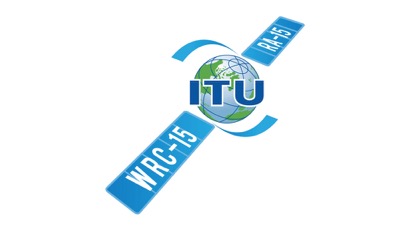
In October we published a post here entitled
This dealt with proposals from European and Asian ITU members to put on the WRC-19 agenda new allocations up to 450 GHz and 1000 GHz, respectively. As far as we can tell the US WRC-15 was totally blindsided by this issue and had no position on it going into this year's conference. We believe that this is partly due to a fundamental flaw in US WRC preparation at both FCC and DOS that is nominally transparent but in actuality is stacked in favor of deep pocket major entities with little or no outreach to other US interests.
The main US deep pocket entities are focused, like most of US industry, on near term gains. They are not apposed to moving the upper limits of spectrum allocations above the present 275 GHz and probably do not even oppose new FCC service rules above 95 GHz, but don't want it to detract from their near term gratification at lower frequencies. Thus given limited resources at FCC and DOS such long term issues get little or no attention.
So as a public service we are linking here to the agenda item for WRC-19 that deals with new allocations in the 275-450 GHz range in the hope that it stimulates interest when WRC-19 preparation begins.
IRS Talks About Stingray,
FCC Doesn't
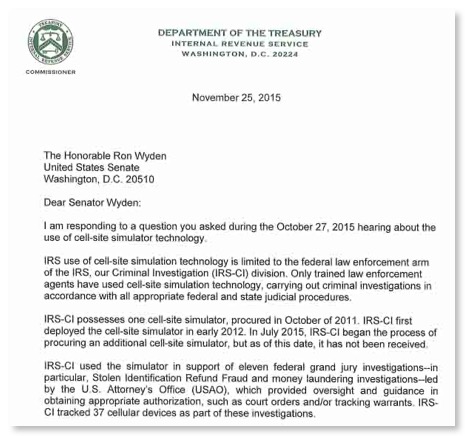
In the above letter from IRS Director John Koskinen to Sen. Wyden is a clear discussion of IRS' use of Stingray, a cell site simulator/"IMSI catcher". In October The Guardian revealed purchasing documents it had FOIA'd from IRS showing the purchase of such units.
They're not cheap! The IRS contract shows that just upgrading a Stingray to the newer "HailStorm" model costs $65,652! Training an extra 6k.
The IRS contract that The Guardian obtained also shows that IRS knows how to properly mark redactions on FOIA documents with the exemption number as mandated by 5 USC 552 (b)(9) - something that FCC has generally not done in the past. (An FCC insider has assured me that FCC has been in general compliance with this requirement, but since FCC does not make readily available past FOIA releases as CIA, NSA, FBI, and NRC do, it is not readily possible to see if FCC has been compliant with the law in the past. However, we have shown in this blog numerous other FCC FOIA releases, including one from the FCC IG, that were not properly marked with exemption numbers. Indeed, the only FCC FOIA release that I have ever seen is that is properly marked dealt with Stingray and it is likely it was actually redacted and properly marked by FBI since its redactions include information readily available elsewhere on the FCC website that FCC staffers would have been aware of.)
The ACLU website contains a map that allegedly shows how broadly Stingray is used by local and state as well as listing 12 federal agencies that reportedly posses this technology - although a few are military and their units may be intended for overseas operation.
As we have stated before, operation of Stingray and similar IMSI catchers in USA by either federal agencies or nonfederal agencies requires some degree of FCC coordination and acquiescence. As several commissioners are concerned about delegation of authority abuse and legislation is being considered that would require more explicit public documentation of delegations of authority (most, but not all of which, are now enumerated in Subpart B of Part 0 of the Commission's Rules) perhaps the commissioners and congressional committees should ask who at FCC authorized this broad use of Stingray-like technology and whether proper procedures were followed.
The IRS letter at the top of this post demonstrates that the basic facts of Stingray use are both now public and are being discussed publicly by other agencies. FCC's continued silence is thus puzzling.

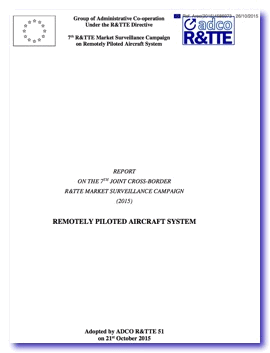
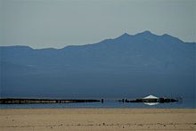
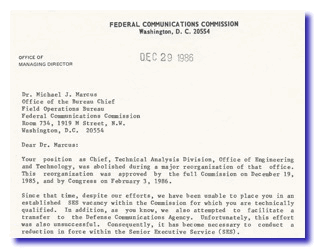
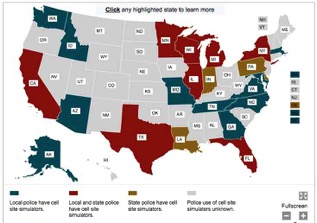



![Validate my RSS feed [Valid RSS]](valid-rss-rogers.png)

